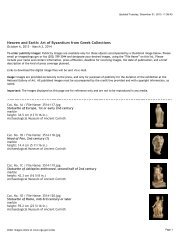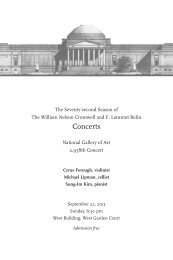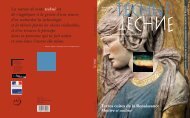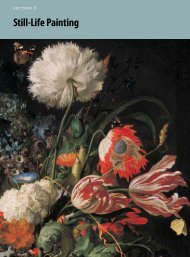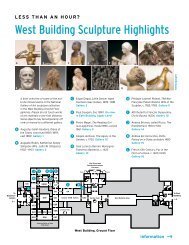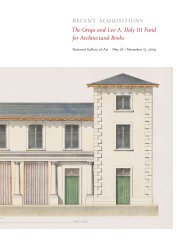The Quest for Immortality - National Gallery of Art
The Quest for Immortality - National Gallery of Art
The Quest for Immortality - National Gallery of Art
You also want an ePaper? Increase the reach of your titles
YUMPU automatically turns print PDFs into web optimized ePapers that Google loves.
2<br />
1<br />
FLOOR ONE<br />
Pharaohs, Sphinxes, and a Scribe<br />
Boat <strong>for</strong> the King<br />
<strong>The</strong> journey to immortality was made by boat.<br />
Why? That’s the way Egyptians got around<br />
in real life—by sailing on the Nile. Look <strong>for</strong><br />
the goddess Maat, pictured with her wings<br />
outspread, at one end <strong>of</strong> this boat. She kept<br />
the cycles <strong>of</strong> birth, death, and rebirth going.<br />
This boat was placed in the tomb <strong>of</strong> Pharaoh<br />
(king) Amenhotep II, an expert horseback<br />
rider and archer. He died in 1400 BC, and his<br />
mummy was found, still wrapped, in 1898,<br />
over three thousand years later.<br />
Sphinx <strong>of</strong> Thutmose III<br />
In the New Kingdom, the Egyptians believed<br />
the sphinx—part lion, part man—was a<br />
sun god. This one is carved with the face <strong>of</strong><br />
Pharaoh Thutmose III. Magically, the sphinx<br />
transfers the lion’s power to the king, along<br />
with the eternal life <strong>of</strong> the sun.<br />
Do you see the pharaoh’s beard? It’s false—<br />
look closely to see the straps that held it in<br />
place. Kings <strong>of</strong> ancient Egypt wore false<br />
beards as part <strong>of</strong> their <strong>of</strong>ficial costume.<br />
Scribe<br />
Have you noticed that many objects here<br />
are covered with writing? <strong>The</strong> written word<br />
was considered very powerful. Name something,<br />
and you can harness its magic.<br />
Egypt’s pr<strong>of</strong>essional writers were called<br />
scribes. This scribe works on a scroll spread<br />
across his lap. Do you see what’s hung over<br />
his left shoulder? It’s a palette holding two<br />
round cakes <strong>of</strong> ink, which were usually<br />
black and red. <strong>The</strong> scribe’s statue was in the<br />
temple <strong>of</strong> the god Amun. Some <strong>of</strong> his words<br />
promise to relay the prayers <strong>of</strong> visitors to<br />
the god. Apparently, many visitors accepted<br />
the <strong>of</strong>fer and rubbed parts <strong>of</strong> the inscription<br />
smooth.<br />
1 Boat from the tomb <strong>of</strong> Amenhotep II,<br />
1427 – 1400 BC, painted wood<br />
2 Sphinx <strong>of</strong> Thutmose III, 1479 – 1425 BC,<br />
granodiorite (stone)<br />
3 Amenhotep, son <strong>of</strong> Hapu, as a scribe,<br />
1390 – 1352 BC, granodiorite (stone)<br />
3<br />
Kheper<br />
Kheper means scarab<br />
beetle. <strong>The</strong> kheper<br />
sometimes lays its<br />
eggs inside a dung<br />
ball. Later, newborn<br />
beetles hatch from<br />
it as if magically<br />
created out <strong>of</strong> nothing.<br />
Ancient Egyptians<br />
believed that, like the<br />
beetle, the sun was<br />
reborn from death.<br />
Thus, the scarab<br />
beetle god Khepri<br />
became a symbol <strong>of</strong><br />
the rising sun and<br />
rebirth.






